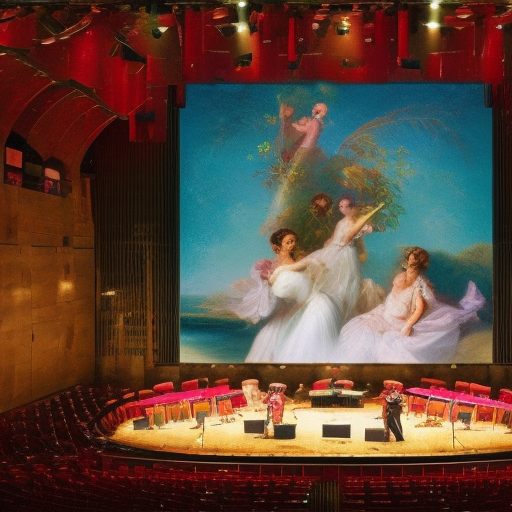
Sweet Symphony
The Power of Music
Music has the incredible ability to touch our souls, evoke emotions, and transport us to a different world. Among the various genres and styles, one that stands out for its harmonious melodies and enchanting tunes is the sweet symphony.
The Beauty of Orchestral Music
Orchestral music, also known as symphonic music, is a genre that combines various musical instruments to create a rich and complex sound. It is a magical blend of strings, woodwinds, brass, and percussion instruments, orchestrated to produce a harmonious masterpiece.
The Role of the Conductor
The conductor plays a pivotal role in an orchestra, leading the musicians and guiding them through the composition. With their gestures and expressions, they bring the music to life, ensuring that every instrument blends seamlessly to create a symphony that resonates with the audience.
The Intricate Arrangements
Orchestral music requires meticulous arrangements, with each instrument having its unique part to play. From the soaring violins to the thundering drums, every note is carefully crafted to contribute to the overall harmony. The arrangement of instruments creates layers of sound, building tension and releasing it in breathtaking crescendos.
The Emotional Journey
Listening to a sweet symphony is like embarking on an emotional journey. The music can evoke a wide range of feelings, from joy and excitement to sadness and contemplation. The melodies can lift our spirits or bring tears to our eyes, connecting with our deepest emotions in ways that words cannot.
The Euphoria of Joyful Melodies
When the orchestra plays uplifting and cheerful melodies, it fills our hearts with joy and happiness. The harmonies and rhythms intertwine, creating an uplifting atmosphere that can make us tap our feet and smile uncontrollably. It is a reminder of the beauty and positivity that exists in the world.
The Poignancy of Melancholic Tunes
On the other hand, melancholic tunes can touch our souls and bring tears to our eyes. The haunting melodies can express sorrow, longing, or nostalgia, resonating with our own experiences of loss or heartache. In these moments, the music becomes a cathartic release, allowing us to process and heal.
Timeless Classics
Throughout history, there have been numerous sweet symphonies that have stood the test of time. Composers like Ludwig van Beethoven, Wolfgang Amadeus Mozart, and Johann Sebastian Bach have gifted the world with masterpieces that continue to captivate audiences today.
Beethoven’s Symphony No. 9
Beethoven’s Symphony No. 9, also known as the “Choral Symphony,” is a monumental work that has become an icon of classical music. Its final movement, featuring the famous “Ode to Joy” chorus, is a celebration of unity, love, and the power of music itself.
Mozart’s Symphony No. 40
Mozart’s Symphony No. 40 in G minor is another masterpiece that showcases the composer’s genius. Its dramatic and passionate melodies have made it one of the most beloved symphonies of all time, leaving a lasting impact on listeners for centuries.
The Universal Language
One of the most remarkable aspects of sweet symphonies is their ability to transcend language barriers. Music is a universal language that can be understood and appreciated by people from all walks of life, regardless of their cultural or linguistic background.
Uniting People Around the World
Orchestras and symphony halls around the world provide a platform for people to come together and experience the magic of sweet symphonies. Regardless of nationality or ethnicity, individuals can connect through their shared love for music, fostering a sense of unity and harmony.
Inspiring Creativity and Imagination
Sweet symphonies have the power to inspire creativity and stimulate the imagination. They can transport us to different eras, evoke vivid imagery, and spark new ideas. Many artists, writers, and filmmakers have drawn inspiration from symphonic music, incorporating its beauty into their own creations.
A Timeless Treasure
Sweet symphonies are not just limited to the past; they continue to be composed and performed today. The legacy of orchestral music lives on, captivating audiences and reminding us of the enduring power and beauty of these timeless treasures.
Preserving the Legacy
Orchestras and music institutions play a crucial role in preserving and promoting sweet symphonies. They ensure that future generations can experience the joy and wonder of orchestral music by nurturing young talents, organizing concerts, and recording performances for posterity.
An Ever-Evolving Artform
While sweet symphonies are rooted in tradition, they also evolve with the times. Contemporary composers continue to push boundaries, incorporating new sounds and techniques into their compositions. This fusion of old and new ensures that sweet symphonies remain relevant and captivating for audiences of all generations.
A Musical Masterpiece
In conclusion, sweet symphonies are a musical masterpiece that captivates and moves us in profound ways. With their harmonious melodies, emotional depth, and universal appeal, they have the power to transform our lives and leave an indelible mark on our souls. So, let the sweet symphony play on, enchanting us with its timeless beauty.